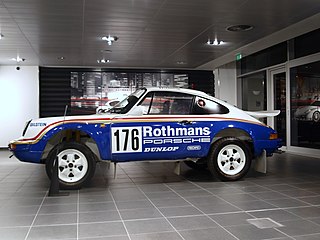
The Dakar Rally or simply "The Dakar", formerly known as the "Paris–Dakar Rally", is an annual rally raid organised by the Amaury Sport Organisation. The rally is an off-road endurance event. The terrain that the competitors traverse is much tougher than that used in conventional rallying, and the vehicles used are typically true off-road vehicles and motorcycles, rather than modified on-road vehicles. Most of the competitive special sections are off-road, crossing dunes, mud, camel grass, rocks, and erg among others. The distances of each stage covered vary from short distances up to 800–900 kilometres (500–560 mi) per day. The rough terrain, driver fatigue, and lack of skill usually results in accidents and serious injuries.

Timo Salonen is a Finnish former rally driver who won the 1985 World Rally Championship season for Peugeot. It was commented of him that he stood out from other drivers, because he was overweight, wore thick glasses and smoked heavily, but still remained one of the fastest and most competitive drivers in the sport. He was also known for his relaxed attitude and for his habit of steering his rally car with one hand only. These factors led to the nickname Löysä ("Slack"). With his 11 rally wins he remained the most successful driver of Group B era (1983–1986) of WRC.

Hubert Auriol was a French professional off-road motorcyclist and auto racer competing in rally raid events. After retiring as a competitor, he served as the director of The Paris-Dakar rally. Auriol is notable for being the first competitor to win the Dakar rally on motorcycles and in automobiles. In 2012, Auriol was named an FIM Legend for his motorcycling achievements.
The 2009 Dakar Rally was the 31st running of the Dakar Rally. In addition to motorcycle, automobile, and truck categories, a separate quad class was added for the first time. The race began on 3 January 2009, and took place across Argentina and Chile. The rally was for the first time to take place outside of Europe and Africa as the location was changed by organizers due to concerns about possible terrorist attacks that resulted in the moving of the 2008 edition from the traditional route to Senegal to Hungary and Romania in the spring.

The 2010 Dakar Rally was the 32nd running of the event. It was held in South America for the second successive time, and ran from 1 to 16 January. The Amaury Sport Organisation and the governments of Argentina and Chile agreed to a return to South America for the event in February 2009.
1980 Dakar Rally also known as the 1980 Paris–Dakar Rally was the 2nd running of the Dakar Rally event, starting from Paris on 1 January and finishing in Dakar on the 23 January. The 1980 event saw vehicle manufacturers such as Yamaha, Volkswagen, Lada, and BMW taking part and the introduction of a truck category.
1981 Dakar Rally also known as the 1981 Paris–Dakar Rally was the 3rd running of the Dakar Rally event. The car class was won by René Metge and Bernard Giroux. The motorcycle class was won by Hubert Auriol.

1984 Dakar Rally also known as the 1984 Paris–Dakar Rally was the 6th running of the Dakar Rally event. The course was extended through Ivory Coast, Guinea, Sierra Leone and Mauritania. 427 competitors started. René Metge and Dominique Lemoyne won the car class with a Porsche 953, which was often called the 911 SC/RS 4x4, and Gaston Rahier won the motorcycles class.
1985 Dakar Rally also known as the 1985 Paris–Dakar Rally was the seventh running of the Dakar Rally event. The race began at Versailles. Patrick Zaniroli and Jean Da Silva won the car class for the Mitsubishi team. Gaston Rahier won his second successive motorcycle class.
1986 Dakar Rally also known as the 1986 Paris–Dakar Rally was the 8th running of the Dakar Rally event. René Metge and Dominique Lemoyne won the car class for the second time, using a Porsche 959; Cyril Neveu won the motorcycle class on a Honda NXR750V, while Giacomo Vismara and Giulio Minelli used a Mercedes-Benz to win the truck class.

1988 Dakar Rally also known as the 1988 Paris–Dakar Rally was the 10th running of the Dakar Rally event. 311 cars, 183 motorcycles, and 109 trucks started the rally. The rally was won by Juha Kankkunen, the motorcycle category was won by Edi Orioli, and the truck category was won by Karel Loprais on a Tatra 815. The event was marred by the death of six people, three participants, a mother and child killed in Mauritania when a camera car ran into a group of spectators, and a 10-year-old girl killed crossing the road in Mali.

1990 Dakar Rally also known as the 1990 Paris–Dakar Rally was the 12th running of the Dakar Rally event. 465 competitors started from La Défense. The rally was won by 1981 world rally champion, Ari Vatanen, for the third time in four years. The motorcycle class was won by Edi Orioli.
1993 Dakar Rally also known as the 1993 Paris–Dakar Rally was the 15th running of the Dakar Rally event. 154 competitors started the rally, which returned to its original route. The rally was won by Bruno Saby and Dominique Seriyes; Stephane Peterhansel won the motorcycle class for the third time.

The 1994 Paris–Dakar–Paris Rally was the 16th running of the Dakar Rally event. The route was from Paris to Dakar and back to Paris. it was the first Dakar Rally organized by Amaury Sport Organisation. Fenouil designed the route.
1995 Dakar Rally also known as the 1995 Paris-Dakar Rally was the 17th running of the Dakar Rally event. The race began outside France for the first time, at Granada in Spain. Pierre Lartigue won the car class for the second year in succession and Stephane Peterhansel won his fourth motorcycle title. Karel Loprais won the truck title in a Tatra 815.
1997 Dakar Rally also known as the 1997 Paris–Dakar Rally was the 19th running of the Dakar Rally event. The rally started and finished in Dakar, taking in a loop including Niger and the Ténéré desert. Jutta Kleinschmidt became the first woman to win a stage of the Dakar Rally. Japanese driver, Kenjiro Shinozuka, won the car class and Stephane Peterhansel won his fifth motorcycle title.
1998 Dakar Rally, also known as the 1998 Paris–Granada–Dakar Rally, was the 20th running of the Dakar Rally event. The rally returned to a traditional Paris to Dakar route last used in 1993. A number of competitors were attacked by unknown attackers near the end of the ninth stage, at Taoudenni in Mali. Jean-Pierre Fontenay won the car class and Stéphane Peterhansel won his sixth and final motorcycle title before switching to the car category for subsequent events. The truck title was won by Karel Loprais in a Tatra 815.
The 2000 Dakar Rally, also known as the 2000 Dakar–Cairo Rally, was the 22nd running of the Dakar Rally event. The event began on 6 January 2000 in Senegal and ended on 23 January in Cairo. It had been re-routed to avoid Mauritania following an armed robbery of competitors in the 1999 rally. Four stages of the rally scheduled to be held in Niger were cancelled following a reported terrorist threat. Competitors were airlifted from Niamey airport to Libya where the rally was restarted five days later at Sabha. The rally was won by French driver Jean-Louis Schlesser and his co-driver Henri Magne in a Schlesser-Renault buggy., with the motorcycle title going to BMW's Richard Sainct and the truck title to Kamaz's Vladimir Chagin.
The 2001 Dakar Rally, also known as the 2001 Paris–Dakar Rally, was the 23rd running of the Dakar Rally event. The format was revised to reduce the amount of airborne assistance to competitors in favour of assistance vehicles. The 2001 rally was 6,600 miles (10,600 km) long and began in Paris, France, on New Year's Day, passing through Spain, Morocco, Western Sahara, Mauritania, Mali, before finishing at Dakar in Senegal. This was the last Paris-Dakar Rally that commenced and finished in the same locations as the original race. Jean-Louis Schlesser won the penultimate stage of the rally to take the lead but was penalised one hour for unsportsmanlike conduct. The rally was won by German Jutta Kleinschmidt, who became the first woman to win the event. The motorcycle class of the rally was won by Italian Fabrizio Meoni, with Karel Loprais winning the truck class.

2005 Dakar Rally also known as the 2005 Paris-Dakar Rally was the 27th running of the Dakar Rally event. The 2005 event was 5,565 miles (8,956 km) long, began in Barcelona on 31 December 2004 and passed through Morocco, Western Sahara, Mauritania and Mali before ending at Dakar in Senegal on 16 January 2005. The course was shorter than in 2004 but was more challenging. A record number of competitors, 696 cars, motorbikes and trucks in total, entered the rally.








